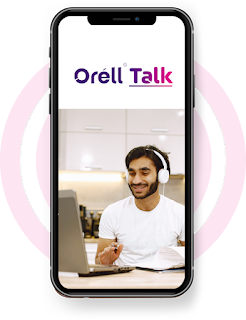Using Phonics with Technology
Orell Talk is a game-changer in language education, providing a comprehensive and user-friendly platform for language learners and instructors. Its cloud-based system allows for seamless integration of language learning into the classroom, making it accessible to students and teachers alike. The software's blended e-Learning system combines traditional classroom learning with online resources, providing a dynamic and engaging learning experience.
Moreover, Orell Talk Language Lab's live-virtual classes offer a
unique opportunity for learners to interact with instructors in real time,
allowing for personalized attention and feedback. This feature has been
particularly beneficial for students who need help with traditional classroom
learning or have limited access to language instructors.
In conclusion, Orell Talk Language Lab is a powerful tool for
transforming language education for millions of learners and instructors
worldwide. Its innovative features, user-friendly interface, and comprehensive
resources make it the go-to platform for language learning.
Phonics is a
vital component of early education in learning the English language. It
involves teaching children the sounds that make up words, and how to combine
these sounds to form words. With the advent of digital language labs and the
new National Education Policy (NEP) in India, there are now more innovative and
effective ways to teach phonics to young learners. In this blog post, we'll
discuss how to use phonics in English in early education with the digital language
lab and NEP.
1.
Understanding
Phonics:
Before we
delve into how to use phonics with digital language labs and NEP, let's first
understand what phonics is. Phonics is a method of teaching children how to
read and write by teaching them the sounds that makeup words. It involves
breaking words down into their component sounds, or phonemes, and teaching
children to blend these sounds together to form words. For example, the word
"cat" has three phonemes - /k/ /a/ /t/.
2.
Using
Digital Language Labs:
Digital
language labs provide an innovative and interactive way to teach phonics to
young learners. They can help children to identify and differentiate between
different phonemes and practice blending them together to form words. In a
digital language lab, children can listen to recordings of different phonemes,
record themselves saying the sounds, and practice blending them together to
form words.
Digital
language labs also provide a fun and engaging way for children to practice
phonics. Many digital language labs have games and activities that teach
phonics in a playful and interactive way. For example, children might have to
match pictures with words or drag and drop letters to form words.
3.
Integrating
Phonics with NEP:
The National
Education Policy (NEP) in India emphasizes the importance of foundational
literacy and numeracy skills in early education. Phonics is a key component of
developing these skills. The NEP also promotes the use of innovative teaching
methods and technology in the classroom, making digital language labs an ideal
tool for teaching phonics.
By
integrating phonics with NEP, teachers can ensure that young learners have a
solid foundation in English language skills. They can use digital language labs
to make phonics lessons more engaging and interactive and help children to
develop strong reading and writing skills from an early age.
In
conclusion, phonics is an essential component of early education in learning
the English language, and digital language labs can provide an innovative and
interactive way to teach phonics to young learners. By integrating phonics with
NEP, teachers can ensure that children have a strong foundation in English
language skills, setting them up for success in their future academic and
professional endeavors.
Please log in to https://orell.com/ to find more information about Language Lab.

.jpg)




Comments
Post a Comment